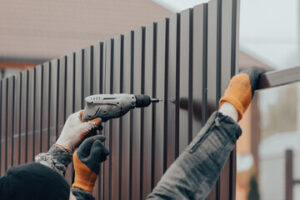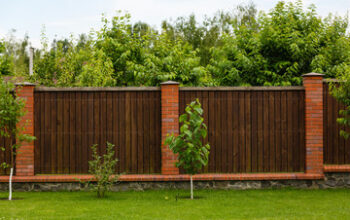Fence Installation Summerville SC is essential to many properties, offering privacy and security. They can also restrict property lines and block out unwanted views.
Before starting your fence project, consult your local building department about codes, restrictions, and permits. Your municipality may have specific regulations regarding fence height, setback distance, and material.

Many homeowners choose to install fences for a variety of reasons. Some want privacy, while others simply want to keep animals or trespassers off their property. Regardless of the reason, a good fence will increase the resale value of your home and help protect gardens and other areas. However, it is important to consider all the costs associated with the installation process before starting work. These costs include permits, materials, and labor. Depending on the size of the project and location, you may need to hire a professional for the job.
The cost of installing a fence can vary widely by region, due to factors such as the size of the yard and fence materials, the design and number of gates, soil conditions, and permit requirements. In general, a fence is less expensive to install on flat land than on sloped property. In addition, some regions have more costly living expenses, which can impact the price of construction and materials.
In order to build a fence, it is necessary to determine your property lines and make sure that you don’t encroach on neighbors’ spaces. This can be a complex process, and it can involve hiring a land surveyor for an average of $380 to $540. In addition, you will need to call the local utilities and have any buried lines marked before digging holes for posts.
Labor is a significant factor in the total cost of fence installation and will affect the price per square foot. Many contractors include the labor in their pricing, but if you’re doing the installation yourself, it will cost more per hour. It’s also important to choose high-quality materials that will stand up to your region’s weather, and use a preservative wood stain.
Other additional fees to consider are the cost of materials and equipment. These can add up quickly, especially if you’re building a large fence. For example, if you’re installing a chain link fence, you’ll need to buy enough rolls of wire for the entire length of your property. You’ll also need to purchase stakes, rebar, cement, and other tools.
Fencing is a great way to beautify your home and yard, but it can also protect your property. There are many different fencing materials available, including chain link, wood, vinyl, aluminum, and wrought iron. Each has its own benefits and disadvantages. Some are less expensive than others, while some are more durable. Choosing the right material depends on your budget, aesthetics, and sustainability.
Fence materials can be purchased at most hardware stores, but it is important to have the right tools for erecting the fence. These tools will make the job much easier and more efficient. Fortunately, most of the necessary tools are basics that you already have in your tool shed or garage. For example, a tape measure is essential for measuring accurately and marking lines on the ground. A torpedo level is a handy tool for checking whether surfaces are straight or plumb. A post-hole digger is also essential for digging holes in the ground. A point trowel is useful for smoothing down mortar haunches and mixes around posts.
Garden stakes and orange spray paint are also useful for marking where you’ll install the fence. This will help you determine how many fence posts you need to order. The stakes are also helpful for identifying the location of utility poles and other underground services. A wheelbarrow is a good idea for transporting dirt and any shrubs or tree parts to the area where you’ll be installing your fence. You’ll also need a pair of work gloves for any handwork.
The most common and cost-effective fencing material is wood. It is easily cut to size with a saw, and it’s easy to work with when building a fence. However, the longevity of wooden fences varies depending on the species and environment. Spruce, for instance, is a cheap option but will rot quickly in damp climates. On the other hand, cypress and hemlock last longer and are resistant to rot.
You’ll also need to factor in any applicable fees for your fence project. These costs may include delivery charges, landscaping the area, or painting your new fence. Some homeowners’ associations (HOAs) have rules that require you to use specific materials for your fence, so this can increase the overall cost of the project.
A fence is a freestanding structure used to confine property or prevent unwelcome intrusions. It can be made of wood, metal or other material and is typically used on houses, farms, and properties to create visual and physical separation. It can also be used to keep livestock in place or as a barrier between homes or commercial spaces. Fences are usually distinguished from walls by their lighter construction.
Fences are built using different materials, and each type has its own pros and cons. Some are more expensive than others, and some materials work better with certain styles of fencing. The best choice for you will depend on your preferences, budget, and the style of property.
Posts are the main support structures for your fence. Typically, you’ll install them every eight feet along the length of your fence. To ensure that your fence doesn’t sag over time, you must install them correctly. To do this, make sure you use a level to ensure that each new post is plumb. Once the posts are set, you’ll add the rails and pickets to complete your fence.
Before installing a fence, you’ll need to consider what kind of gate you want. Some people prefer a closed gate, while others prefer a gate that opens and closes. There are also many different styles of gates, so it’s important to choose one that fits the look of your home.
During the design phase, it’s important to discuss your plan with your neighbors before starting construction. This will help to avoid disagreements over boundaries and property lines. You should also communicate with local officials to find out if your property requires any permits.
You’ll need to purchase the materials for your fence, including the posts, rails, and pickets. Wood is the most common material for fences, and there are several types of wood available. Cedar is a popular option, as it is durable and resistant to insects. It can be treated with a penetrating sealant to prolong its lifespan.
If you choose a picture frame-style fence, you’ll need to add a kickboard to protect the bottom of your fence from damage. This is a piece of pressure-treated wood that’s placed at the bottom of your fence. It’s more durable than regular wood and resists rot and pests, which will extend the life of your fence.
Before beginning a fence project, it is important to know the local codes and regulations for your neighborhood. These rules may include setbacks, property lines and height restrictions. It is also a good idea to have your property surveyed. This will ensure that the fence is completely inside of your property line and not overhanging onto your neighbor’s land. In addition, you may need to obtain a permit for the work, especially in urban areas.
Depending on the size of your property and the type of fence, you may be required to submit a permit application and fee. It is best to apply for a permit early so that you will have plenty of time to prepare your site and submit the necessary documentation. Having your permit in hand will help you avoid any delays during construction and can protect you from a potential fine.
When constructing a fence, it is important to properly space posts and pickets. The spacing will determine the strength of the fence and prevent gaps that can let in water or light. You should also be sure to dig the holes to the proper depth and use a post-hole digger or power auger if needed.
Once the posts are in, you can install the fence paneling or pickets. Using a carpenter’s level and the proper tools, you will be able to install each piece correctly. If you are installing panels, it is important to make sure that they are flush with the bottom of the post and that there are no gaps in between each panel.
If you are installing a wood fence, it is also a good idea to seal the paneling to protect it from moisture and insects. This will prolong the life of your fence. You should also apply a layer of exterior caulk to the bottom of the posts and around any exposed wood.
Some cities require a building inspector to inspect the construction of your fence. If you are unsure whether you will need a permit, contact your town’s building inspector or visit the city’s website.

